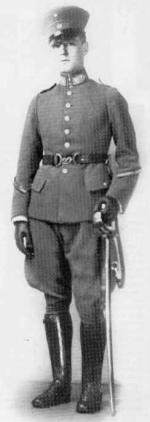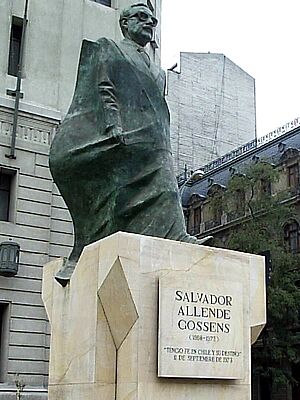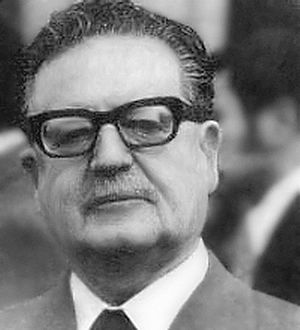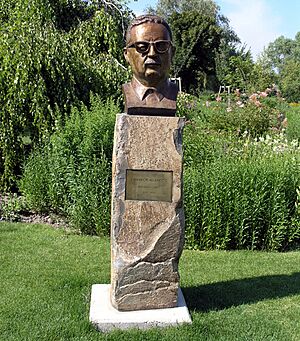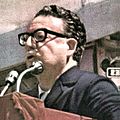Salvador Allende facts for kids
Quick facts for kids
Salvador Allende Gossens
|
|
|---|---|
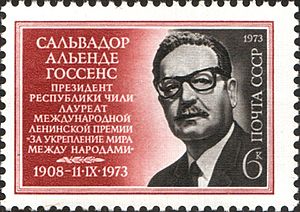 |
|
| Chile's First Socialist President | |
| In office November 3, 1970 – September 11, 1973 |
|
| Vice President | Carlos Prats |
| Preceded by | Eduardo Frei Montalva |
| Succeeded by | Augusto Pinochet Ugarte |
| Personal details | |
| Born | June 26, 1908 Valparaiso, Chile |
| Died | September 11, 1973 Santiago, Chile |
| Political party | Socialist Party of Chile |
| Spouse | Hortensia Bussi |
Salvador Allende Gossens (born June 26, 1908 – died September 11, 1973) was a doctor, senator, and government minister for health in Chile. He became the President of Chile on November 3, 1970, and served until his death on September 11, 1973. He was the first democratically elected socialist leader in the world.
Salvador Allende's Life Story
Early Years
Salvador Allende was born on June 26, 1908, in Valparaiso, a port city in Chile. His family was well-off. Allende had a mixed background, which is called mestizo. This means he had both European and Native American ancestors. His father, Salvador Allende (senior), was a lawyer with Basque roots. His mother, Laura Gossens, had a Belgian Jewish background but became Catholic.
School and University
In 1918, Allende's father sent him to study at the Instituto Nacional (National Institute) in Santiago. After school, he completed his required military service. Then, he went to the University of Chile to study medicine.
Allende was a smart, friendly, and well-liked student. He was very good at debates and public speaking. He quickly became a student leader and was the vice-president of the FECH (Student Federation of Chile). While studying, Allende wanted to earn his own money. He worked as a paramedic in ambulance services and as an assistant in pathology. He finished his medical degree in 1933.
Entering Politics
Allende was one of the people who started the Socialist Party of Chile. In 1938, he became a minister of health in the government. He then served as a senator from 1945 to 1969. He was also the President of the Chilean Senate from 1966 to 1969.
Running for President
Allende first tried to become president in the 1952 elections but did not win. He was determined and tried again in 1958 and then in 1964. He did not win those times either.
Allende traveled all over Chile, from one end to the other. He spoke to peasants in the south and miners in the north. He also held large meetings in big cities. It was hard for Allende to win elections because other parties ran "scare campaigns" against him. These campaigns often got money from big international companies and powerful groups in Chile, like private banks.
Election Results
Finally, in 1970, he won the election and became the President of Chile. Many working people who had voted for him before were surprised and happy, as they thought he might never win.
Allende's Goals
Allende always ran for president with the same socialist plan. He wanted to fix the big problem of inequality in Chile, where some people were very rich and many were very poor. He believed this poverty was because Chileans did not control their own natural resources and important industries, like banks, copper mines, and electricity companies.
Allende promised to nationalize these important industries. This meant the government would take control of them for the benefit of all Chileans. He also wanted to create a good public health system and an education system that would be free and open to everyone. During the Cold War (a time of tension between the U.S. and the former U.S.S.R), some people worried that Chile would become too close to the USSR or Cuba.
Big Changes for Chile
Allende's ideas for Chile were very different from what most people were used to. For example, he was said to be an atheist and a follower of Karl Marx's ideas. He was a non-practicing Catholic. This was seen as unusual in a country that was very Catholic and valued traditional family ways. People were often taught that political freedoms, like being able to choose politicians from different parties, were more important than solving problems like extreme poverty.
Allende wanted to make deep changes to Chilean society very quickly. These kinds of changes can sometimes cause big divisions between people who support them (called revolutionaries) and those who are against them (called reactionaries). In history, such situations can sometimes lead to violence, like a civil war (when groups within the same country fight each other) or a military coup (when the government is overthrown by the military).
Effects of the Changes
Because of these big changes, many skilled people in Chile, like university professors, doctors, and business people, left the country. This made it harder for Allende's reforms to work. For example, he wanted to improve health services and create more places at universities for underprivileged people, but many specialists and doctors were leaving.
A Peaceful Revolution
However, Allende was special because he tried very hard to stop any violence. He called his revolution a "peaceful one within democracy" or "the Chilean road to socialism." In 1973, Allende's opponents accused him of secretly preparing for a war. They claimed his supporters were hiding illegal weapons from communist Cuba in poor areas and the countryside.
To show this was not true, Allende allowed the Chilean Army to use a "weapons control law." This law let the military search for illegal weapons anywhere in the country. After searching everywhere, the Chilean army confirmed that they had not found any large amounts of weapons, as the opposition claimed. This made more people support Allende and allowed him to focus on the next election.
Allende's Plan for Chile
Allende came to power with a socialist plan. He wanted Chile's resources and wealth to be owned by Chileans and shared more fairly. He started by nationalizing major industries. For example, Chile had some of the largest copper mines in the world, but they were owned by powerful U.S. business people, not Chileans.
This caused a big problem with the U.S. government. They saw Allende taking control of these industries as an attack on U.S. interests and a threat to their money invested in South America.
The Coup: September 11, 1973
The American Central Intelligence Agency (CIA) was said to be involved in overthrowing Allende's government. Allende was a socialist, and many of his plans were based on socialist ideas. He created universal health care for everyone, made education better, and took more control over the economy. He died in 1973.
The people who overthrew Allende replaced him as president. The new ruling group, called a Junta, said they took power because "Chile could no longer tolerate the cancer of Marxism." The Pinochet government claimed Allende had broken the Chilean Constitution. This was strange, as Pinochet later wrote a completely new constitution himself.
After the coup, many false stories and myths appeared about Allende. These stories tried to make him seem like a coward, weak, or cruel person.
His Place in History
Allende became famous around the world because he was the first democratically elected socialist leader in Chile and the first democratically elected Marxist leader anywhere. Many people felt that Allende's election meant a new time was beginning. They believed that big changes to society, especially in developing countries, could happen peacefully through an election.
Allende is now one of the most remembered Latin American political figures in history. Since his death, monuments, statues, parks, and streets have been named in his honor all over the world. In France alone, more than 320 public places are named after Allende. Governments in many countries have also approved naming schools and educational departments after him.
Even though Pinochet ruled Chile with the military for 17 years and tried to erase Allende's importance, Allende was officially honored in Chile. He was recognized as someone who defended representative democracy (people's right to choose their leaders through fair elections) with a state funeral in 1990. A monument was also built outside the Moneda Presidential Palace (Chile's government house), where he died defending the democratically elected government he led.
Images for kids
See also
 In Spanish: Salvador Allende para niños
In Spanish: Salvador Allende para niños


